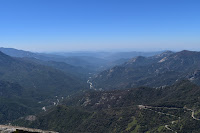 |
Columbia River from Women's
Forum Overlook |
As we moved our way north our next stop was a week just east of Portland Oregon on the Historic Columbia River Highway - US 30. We spent a good part of two different days along the
Columbia River Gorge. The first one was on the
Historic Columbia River Highway which is certainly not a highway by today's standards. It is a narrow two lane road winding along the cliff of the river with the purpose of giving views of the river gorge and numerous water falls. We stopped at vistas and many water falls to fill a wonderful day.
 |
View looking across river from
Women's Forum Overlook |
The second day spent along the river was much faster paced. We drove east on I-84 which hugs the river. We enjoyed the scenery at the few view points that are available, the town of Cascade Locks, and the
Bradford Island Visitor Center which is at the Bonneville Lock and Dam. This visitor center has exhibits related to the locks and dam as well has some history of the Columbia River. It also has viewing windows into the fish ladder so you can see fish swimming by. The top of the fish ladder funnels down to a scant 18 inches wide and goes by a window so the fish can be counted.
 |
| Bonneville Hydroelectric Dam |
Yes, someone sits there and counts fish (24/7) and tracks them by species. We had a very good lunch in Hood River, a really neat little town, at the Full Sail Brewpub that has a great view of the river. We drove a few miles south from Hood River on US 35 to the Panorama Viewpoint to get a spectacular view of Mount Hood. We drove another 10 miles or so east on I-84 until we got a good feel for how the terrain opens up and becomes more arid. At this point we decided to turn around and head back.
 |
| Fish going through counting tunnel |
 |
| Fort Vancouver |
Another day was spent driving to Vancouver, Washington, across the river from Portland, to go to
Fort Vancouver National Historic Site. This is a reproduction of the Columbia Department headquarters of the Hudson's Bay Company built around 1825. For two decades the fort was the center of fur trade for the Pacific northwest. After America gained control of the land, the company continued to operate the fort but trade slowly diminished until they moved out in 1860. After abandonment the structures were destroyed by fires and decay in 1866. Paintings, written accounts and archaeological work gave the information necessary to create an accurate recreation of buildings and activities within and around the fort.
 |
| End of the Oregon Trail site |
We took the long route home from Fort Vancouver to go to the "
End of the Oregon Trail" on the south side of Portland. We got there late so we didn't have time to tour the inside exhibits but we walked around the grounds and read the interpretive signs, which ultimately, told us what we wanted to know.
 |
| Bridal Veil Falls |
 |
| Multnomah Falls |
 |
| Columbia River Gorge along I-84 |
 |
| Mount Hood from Panorama Viewpoint |
 |
| Fort Vancouver outside |
 |
| Fort Vancouver |
 |
| Fort Vancouver |
 |
| End of the Oregon Trail plaque |











































